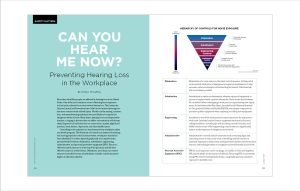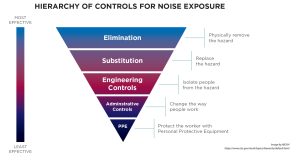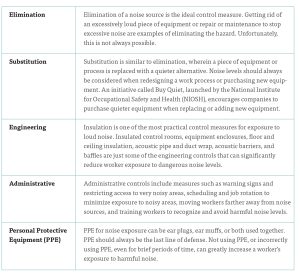Safety Matters: Can You Hear Me Now? Preventing Hearing Loss in the Workplace
More than 48 million people are affected by hearing loss in the United States. One of the most common causes of hearing loss is exposure to loud noise, referred to as noise induced hearing loss. The Centers for Disease Control and Prevention have called noise induced hearing loss the most common work-related injury. Workers in the mining, construction, and manufacturing industries are most likely to be exposed to dangerous levels of noise. Many times, hearing loss is accompanied by tinnitus, a ringing in the ears that can affect concentration and disrupt sleep. Exposure to loud noise also can cause stress, anxiety, high blood pressure, heart disease, depression, and other health issues.
Controlling noise exposure is a key element of any workplace safety and health program. The Hierarchy of Controls is a method of selecting the most appropriate control measure when a workplace hazard has been identified. It is often depicted graphically as an upside-down pyramid with five layers: elimination, substitution, engineering, administrative, and personal protective equipment (PPE). The most effective control measure is at the top of the pyramid, and the least effective control is at the bottom. Oftentimes, more than one control measure is needed, but one should always consider control measures higher on the hierarchy first.
Engineering and administrative controls are not just a recommended best practice, they are required by federal regulation when noise levels are too high. OSHA’s standard on occupational noise exposure states that feasible administrative or engineering controls must be utilized first, and only then can PPE be used to further lower employee noise exposure. Hearing protection in the form of ear plugs or ear muffs should be a last resort after engineering and administrative controls have been used.
Like most OSHA health standards, the standard on occupational noise exposure starts with an exposure assessment. There are two trigger levels in the noise standard: a permissible exposure limit of 90 decibels, measured on the A scale (90 dBA); and an action level of 85 dBA. Both are measured using an 8-hour, time-weighted average (TWA). Noise exposure can be determined with a sound level meter for area sampling, or with a personal noise dosimeter worn by employees for a full shift that determines their “dose” of noise exposure (100% dose is equal to the permissible exposure limit of 90 dBA TWA). NIOSH has a free app that turns your phone into a sound level meter (currently only available for iOS devices). A good rule of thumb is that you may have a noise problem if workers have to shout to communicate with each other.
When noise exposure equals or exceeds the action level of 85 dBA, employees must be enrolled in a Hearing Conservation Program to protect their hearing. Elements of a Hearing Conservation Program include audiometric testing, training, and hearing protection. Audiometric testing establishes a worker’s baseline hearing level, which is compared to annual rechecks to catch potential hearing loss as early as possible. Training must also be conducted annually, with an emphasis on the effects of noise exposure on hearing and the importance of hearing protectors. The cost of annual audiograms, annual training, and hearing protective devices should always be considered when determining the economic feasibility of engineering controls. Noise control engineering will often be cheaper in the long run than a Hearing Conservation Program.
Exposure to loud noise does not just damage your hearing; it can have a detrimental effect on overall quality of life. Noise-induced hearing loss can lead to social isolation and depression. Stress from noise exposure can raise blood pressure and the risk of heart attack and stroke. Acoustic and noise insulation can improve your workers’ overall well being. In addition to making your workplace safer and more productive, controlling noise exposure can make your employees healthier and happier. Noise insulation is a win-win for employers and employees.



